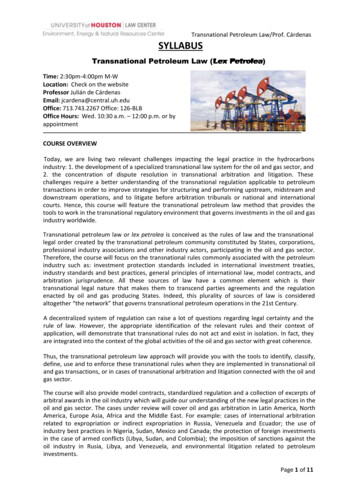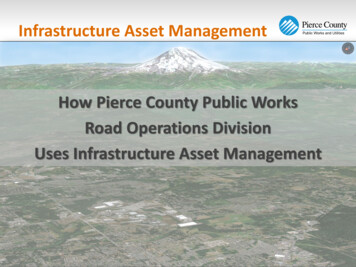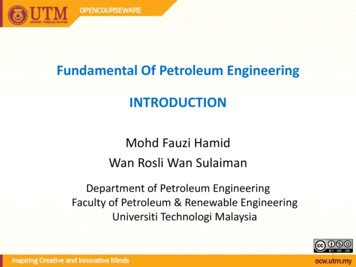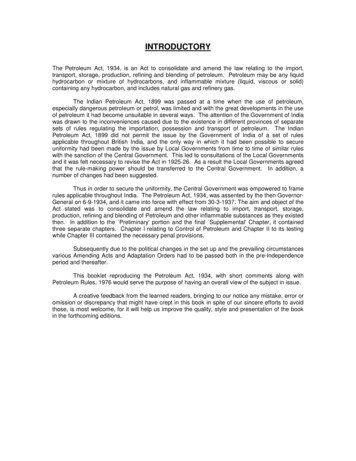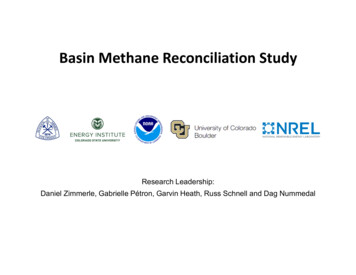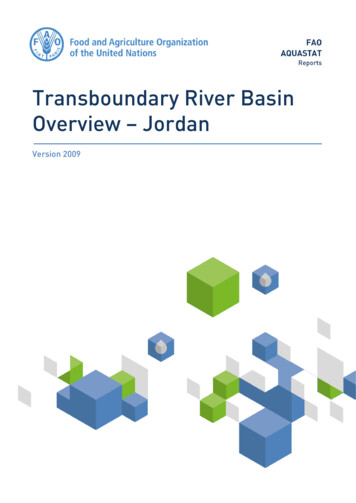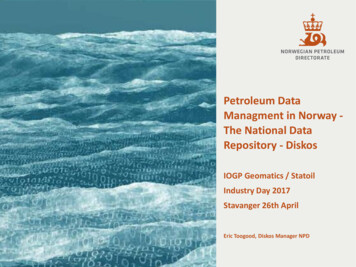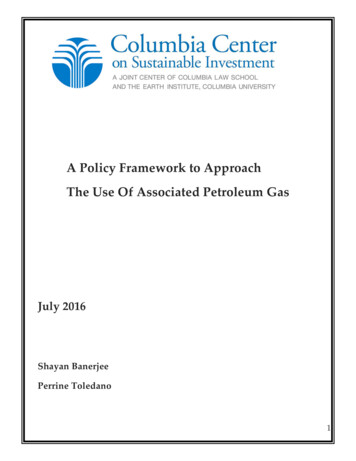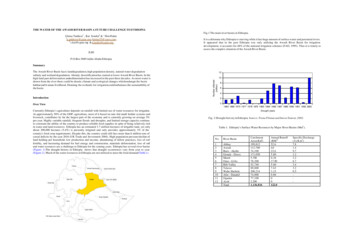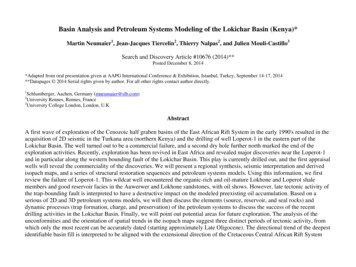
Transcription
Basin Analysis and Petroleum Systems Modeling of the Lokichar Basin (Kenya)*Martin Neumaier1, Jean-Jacques Tiercelin2, Thierry Nalpas2, and Julien Mouli-Castillo3Search and Discovery Article #10676 (2014)**Posted December 8, 2014*Adapted from oral presentation given at AAPG International Conference & Exhibition, Istanbul, Turkey, September 14-17, 2014**Datapages 2014 Serial rights given by author. For all other rights contact author directly.1Schlumberger, Aachen, Germany (mneumaier@slb.com)University Rennes, Rennes, France3University College London, London, U.K2AbstractA first wave of exploration of the Cenozoic half graben basins of the East African Rift System in the early 1990's resulted in theacquisition of 2D seismic in the Turkana area (northern Kenya) and the drilling of well Loperot-1 in the eastern part of theLokichar Basin. The well turned out to be a commercial failure, and a second dry hole further north marked the end of theexploration activities. Recently, exploration has been revived in East Africa and revealed major discoveries near the Loperot-1and in particular along the western bounding fault of the Lokichar Basin. This play is currently drilled out, and the first appraisalwells will reveal the commerciality of the discoveries. We will present a regional synthesis, seismic interpretation and derivedisopach maps, and a series of structural restoration sequences and petroleum systems models. Using this information, we firstreview the failure of Loperot-1. This wildcat well encountered the organic-rich and oil-mature Lokhone and Loperot shalemembers and good reservoir facies in the Auwerwer and Lokhone sandstones, with oil shows. However, late tectonic activity ofthe trap-bounding fault is interpreted to have a destructive impact on the modeled preexisting oil accumulation. Based on aserious of 2D and 3D petroleum systems models, we will then discuss the elements (source, reservoir, and seal rocks) anddynamic processes (trap formation, charge, and preservation) of the petroleum systems to discuss the success of the recentdrilling activities in the Lokichar Basin. Finally, we will point out potential areas for future exploration. The analysis of theunconformities and the orientation of spatial trends in the isopach maps suggest three distinct periods of tectonic activity, fromwhich only the most recent can be accurately dated (starting approximately Late Oligocene). The directional trend of the deepestidentifiable basin fill is interpreted to be aligned with the extensional direction of the Cretaceous Central African Rift System
(NW to SE). This suggests that the Lokichar Basin might have been formed already during the Cretaceous as part of the CentralAfrican Rift System, which hosts major oil reserves in the neighboring Soudan. Sandstones of Cretaceous age are observed inthe Lapur Range in the northern Turkana area, and similar sediments might be present below the Cenozoic basin.References CitedJoubert, P., 1966, Geology of the Loperot area: Geological Survey of Kenya, Report No. 74, p. 51.Morley, C.K., D.K. Ngenoh, and J.K. Ego, 1999, Introduction to the East African Rift System, in C.K. Morley (ed.), Geoscienceof rift systems-evolution of East Africa: AAPG Studies in Geology, v. 44, p. 1-18.Morley, C.K., F.M. Karanja, W.A. Wescott, D.M. Stone, R.M. Harper, S.T. Wigger, and R.A. Day, 1999, Geology andGeophysics of the Western Turkana Basins, Kenya, in C.K. Morley (ed.), Geoscience of rift systems-evolution of East Africa:AAPG Studies in Geology, v. 44, p. 19-54.Tiercelin, J.-J., J.-L. Potdevin, C.K. Morley, M.R. Talbot, H. Bellon, A. Rio, B. Le Galla, and W. Vetel, 2004, Hydrocarbonpotential of the Meso-Cenozoic Turkana Depression, northern Kenya. I. Reservoirs: depositional environments, diageneticcharacteristics, and source rock–reservoir relationships: Marine and Petroleum Geology, v. 21, p. 41–62.Tiercelin, J.-J., P. Thuo, T. Nalpas, and J.-L. Potdevin, 2009, Hydrocarbon Prospectivity in Mesozoic and Early Cenozoic RiftBasins in Central/Northern Kenya: Search and Discovery Article #10188, Web Accessed November 28, nts/2009/10188tiercelin/images/tiercelin ppt.pdf.html.Tiercelin, J.-J., P. Thuo, J.-L. Potdevin, and T. Nalpas, 2012, Hydrocarbon Prospectivity in Mesozoic and Early–MiddleCenozoic Rift Basins of Central and Northern Kenya, Eastern Africa: in D. Gao, ed., Tectonics and sedimentation: Implicationsfor Petroleum Systems, AAPG Memoir 100, p. 179–207.
Basin Analysis and Petroleum Systems Modelingof the Lokichar Basin (Kenya)Martin Neumaier, Jean-Jacques Tiercelin,Thierry Nalpas, Julien Mouli Castillo
Introduction East African RiftSystemCentral African RiftSystemLokichar Basin
Tiercelin et al., 2004Introduction Cenozoic half grabenEocene (?) to Miocenelacustrine and fluvial sedimentsCapped by Middle Miocene basaltsMorley et al., 1999Morley et al., 1999
Tiercelin et al., 2004Introduction First wave of exploration in the 1980’s and early 90’s Loperot-1 Discovery– Good source and reservoir rocks– Oil shows– Not commercialMorley et al., 1999Morley et al., 1999
Introduction First wave of exploration in the 1980’s and early 90’s Loperot-1 Discovery– Good source and reservoir rocks– Oil shows– Not commercial Recent second wave of exploration– Discoveries– Reached commercial ps.asp
Data 2D seismic data Loperot-1 well Outcrops
Seismic Interpretation Sequence AD1
Seismic Interpretation Sequence A Sequence BD1
Seismic Interpretation Sequence A Sequence BD1
Seismic Interpretation Sequence A Sequence BD1D2
Seismic Interpretation Sequence A Sequence B Sequence CUpperOligoceneLokhoneFm (shales)D1D2
Seismic Interpretation Sequence A Sequence B Sequence CLower-MiddleMioceneAuwerwerSandstonesD1D2
Seismic Interpretation Sequence A Sequence B Sequence CLower-MiddleMioceneAuwerwerSandstonesD1D2
Seismic Interpretation Sequence A Sequence B Sequence CMiddleMiocene (1)AuwerwerBasaltsD1D2
Seismic Interpretation Sequence A Sequence B Sequence CMiddleMiocene (2)FluvialsedimentsD1D2
Structural Synthesis 2 major unconformities 3 sequences Tectonic inversion(Late Miocene)D2D1
Structural Synthesis 2 major unconformities 3 sequences Tectonic inversion(Late Miocene)Loperot-1
SWLoperot-1Loperot-1NEoSec (TWT)x--::;::- 1"'---- 2North LokicharBasinLoperot-1 Ni
SWLoperot-1NExRecent erosionSec (TWT) Loperot-10.35%Loperot-1
SWLoperot-1 NExRecent erosionSec (TWT) Loperot-1Tectonic inversionresponsible fortrap/seal failure?0.35%Loperot-1
Basin Modeling LithologiesWSWLoperot-1ENEPlio-Peistocene fluvial sedimentsAuwerwer interbedded shalesAuwerwer sandstonesAuwerwer basaltsLoperot sandstonesLoperot shale (non-source)Loperot shale (source)unknown10 km3000 mLokhone shale (source)
Basin Modeling Lokhone Shales (Oligocene to Early Miocene)Structural historyWSWENE3000 m10 km
Basin Modeling Lokhone Shales (Oligocene to Early Miocene) Auwerwer Sandstones (Middle Miocene)Structural historyWSWENE3000 m10 km
Basin Modeling Structural history Lokhone Shales (Oligocene to Early Miocene) Auwerwer Sandstones (Middle Miocene) Auwerwer Basalts (12.5 to 10.7 Ma)WSWENE3000 m10 km
Basin Modeling Structural history Lokhone Shales (Oligocene to Early Miocene) Auwerwer Sandstones (Middle Miocene) Auwerwer Basalts (12.5 to 10.7 Ma) Fluvial sediments (?) (Late Miocene)WSWENE3000 m10 km
Basin Modeling Structural history Lokhone Shales (Oligocene to Early Miocene) Auwerwer Sandstones (Middle Miocene) Auwerwer Basalts (12.5 to 10.7 Ma) Fluvial sediments (?) (Late Miocene)WSWENEUplift(Lokhone Fault Footwall)3000 m10 km
Basin Modeling Structural historyWSW Lokhone Shales (Oligocene to Early Miocene) Auwerwer Sandstones (Middle Miocene) Auwerwer Basalts (12.5 to 10.7 Ma) Fluvial sediments (?) (Late Miocene) Fluvial sediments (Pliocene - Pleistocene)ENE3000 m10 km
Basin Modeling Loperot-1 Erosion of ca. 900m Lokhone Shale marginally mature Loperot Shale in oil windowD3 Corrected BHT 150 C0.35%LokD2“Oil window”D1Lop
Basin Modeling Temperature ( C)WSW Corrected BHT 150 CLocal variations due tolithologyLoperot-150 C100 C150 C200 C3000 m10 km250 C
Basin Modeling Transformation ratioWSW Lokhone Shale only marginally mature at Loperot-1Effective kitchen of Lokhone Shale towardsbounding faultLoperot Shale matureLoperot-1ENE50 C100 C150 C200 C3000 m10 km250 C
Basin Modeling Transformation ratio Lokhone Shale only marginally mature at Loperot-1Effective kitchen of Lokhone Shale towardsbounding faultLoperot Shale mature
Basin Modeling Transformation ratio Lokhone Shale only marginally mature at Loperot-1Effective kitchen of Lokhone Shale towardsbounding faultLoperot Shale matureUpper LokhoneShale
Basin Modeling Transformation ratio Lokhone Shale only marginally mature at Loperot-1Effective kitchen of Lokhone Shale towardsbounding faultLoperot Shale matureMiddle LokhoneShale
Basin Modeling Transformation ratio Lokhone Shale only marginally mature at Loperot-1Effective kitchen of Lokhone Shale towardsbounding faultLoperot Shale matureLower LokhoneShale
Basin Modeling Transformation ratio Lokhone Shale only marginally mature at Loperot-1Effective kitchen of Lokhone Shale towardsbounding faultLoperot Shale matureUpper Loperot Shale
Basin Modeling Transformation ratio Lokhone Shale only marginally mature at Loperot-1Effective kitchen of Lokhone Shale towardsbounding faultLoperot Shale matureLower Loperot Shale
Basin Modeling Hydrocarbon migrationWSWLoperot-1ENE50 C100 C150 C200 C3000 m10 km250 C
Basin Modeling Hydrocarbon migration HC expelled from Loperot Shale (and some fromLokhone Shale) mostly migrate through fault zonestowards rift flank (East)Oil showsWSWOil showsLoperot-1ENE50 C100 C150 C200 C3000 m10 km250 C
Basin Modeling Hydrocarbon migrationWSWNgamiaTwiga SouthEskales HC expelled from Loperot Shale (and some fromLokhone Shale) mostly migrate through fault zonestowards rift flank (East)Charge from Lokhone Shale towards bounding faultOil showsOil showsLoperot-1ENE50 C100 C150 C200 C3000 m10 km250 C
Lokichar Basin RevisitedEtomTwigaSouthLoperot-1Ewoi“String of Pearls” PlayAgeteEkalesRift Flank Play(Loperot-1)EkunyukNgamiaAmosing
Where else? Cenozoic Play–––Deposition of lacustrine source rocks are tied to tectonicsGetting replaced by volcanics towards the northLokichar Basin limited analogue only for neighboring North Kerio BasinLokichar Basin
Where else? Cenozoic Play––– Deposition of lacustrine source rocks are tied to tectonicsGetting replaced by volcanics towards the northLokichar Basin limited analogue only for neighboring North Kerio BasinCretaceous Play?Lokichar Basin
Where else? Cenozoic Play––– Deposition of lacustrine source rocks are tied to tectonicsGetting replaced by volcanics towards the northLokichar Basin limited analogue only for neighboring North Kerio BasinCretaceous Play?–––Lapur SandstonesReservoir quality?Gas?Lapur RangeLokichar BasinTiercelin et al., 2012Tiercelin et al., 2009Tiercelin et al.,
Summary Two proven plays in the Cenozoic Lokichar Basin Shale resource potential? Analogue for other Cenozoic Basins? Deep Cretaceous Play in Lokichar Basin?
Basin Analysis and Petroleum Systems Modeling of the Lokichar Basin (Kenya)* Martin Neumaier1, Jean-Jacques Tiercelin2, Thierry Nalpas2, and Julien Mouli-Castillo3 Search and Discovery Article #10676 (2014)** Posted December 8, 2014
